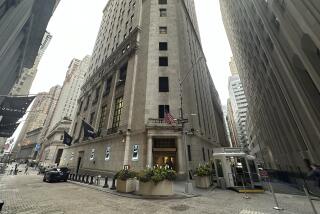Unemployment Inches Up; Dow Zooms Ahead
WASHINGTON — The unemployment rate edged up to 5.4% in January from 5.3% at the end of last year as the nation’s robust job market attracted thousands of potential new workers, the Labor Department reported Friday.
The economy generated a healthy 271,000 new jobs, but the labor force grew even faster, expanding by 509,000, a sign of growing confidence in the prospect of finding work.
Meanwhile, hourly wages rose by only a penny, a sign of inflation-free growth that was welcomed on Wall Street. After an up-and-down day, interest rates closed lower and blue-chip shares soared, with the Dow Jones industrial average gaining nearly 83 points to close within about 26 points of its all-time high of 6883.90.
The economy is now enjoying an enviable combination of healthy growth, low levels of unemployment and very modest price increases, analysts agreed.
January’s job gains “show that the economy is basically on a stable growth track,” said Jerry Jasinowski, president of the National Assn. of Manufacturers. He predicted that the economy would continue to be “buoyant” in the early months of this year.
“People [who were] on the sidelines are encouraged enough that they are moving back into the search for work,” said Gary Schlossberg, an economist with Wells Fargo Bank in San Francisco.
California, which lagged behind the nation in coming out of the recent recession, is now doing better in economic performance. The state expects job growth of 2.3% this year, compared to 1.6% for the nation, said Tapan Munroe, chief economist for Pacific Gas & Electric Co.
California “leads the nation” in both job creation and income growth, he said. The state’s jobless rate, most recently reported at 6.8% for December, is traditionally higher than the national rate because California is a magnet for job-seekers.
Responding to a strong job market, Americans set a record in January for work-force participation. About 67.2% of the population 16 and older were either working or looking for a job.
Many economists had feared that an unemployment rate of less than 6% would cause labor shortages, drive up wages and trigger inflation. But instead, the work force has grown, productivity has risen and wage increases have been modest since August 1994, the last time the jobless rate was as high as 6%.
All the statistics on new jobs in January, without any big wage boosts, are “very healthy,” said Barry Rogstad, president of the American Business Conference, which represents high-growth firms. “We are seeing strength all across the board,” he said.
The jobs report provided good news for the Clinton administration. “We’re happy with the report because it reflects steady, continued growth in the economy with low rates of inflation and high rates of employment,” White House Press Secretary Mike McCurry said.
Another government study offered further signs that the strong economic performance will continue. Inventories held by wholesalers dropped sharply in December, reaching the lowest level in more than a decade, the Commerce Department said.
The wholesale merchants had 1.25 months worth of merchandise on hand in December, the smallest inventory since an identical figure in May 1985. This means that companies will be busy in coming weeks and months producing goods to restock the inventories of retailers.
Across the nation, there were 167,000 service jobs added in January, with strong growth in temporary employment, health, computer processing services and engineering services. Manufacturing employment rose by 18,000, continuing an advance that began in October.
The overall employment data “are very welcome,” said Rep. H. James Saxton (R-N.J.), chairman of Congress’ Joint Economic Committee, which discussed the monthly report at a hearing. But the good news about jobs was once again accompanied by “stagnation or declines in middle-class earnings, reflecting a problem that has persisted through most of this business-cycle expansion,” Saxton said.
Salaries are rising barely as fast as the consumer price index, meaning that most families do not have more buying power. Two-income families, especially those in which both spouses have a college education, have been enjoying real gains, but other groups are lagging behind.
Average hourly earnings advanced a scant 1 cent in January, reaching $12.06. Average earnings rose 44 cents during the year, a 3.8% advance.
There were 135.8 million Americans at work in January and 7.3 million unemployed. Among major groups, the jobless figures: men, 4.6%, up from 4.4% in December; women, 4.6%, down from 4.9%; whites, 4.6%, unchanged; blacks, 10.8%, up from 10.5%; and Latinos, 8.3%, up from 7.7%.
More to Read
Inside the business of entertainment
The Wide Shot brings you news, analysis and insights on everything from streaming wars to production — and what it all means for the future.
You may occasionally receive promotional content from the Los Angeles Times.










